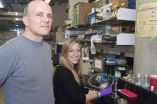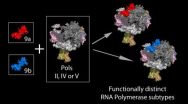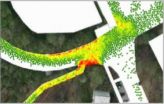(Press-News.org) (Santa Barbara, Calif.) –– What if bacteria could talk to each other? What if they had a sense of touch? A new study by researchers at UC Santa Barbara suggests both, and theorizes that such cells may, in fact, need to communicate in order to perform certain functions. The findings appear today in the journal Genes & Development.
Christopher Hayes, UCSB associate professor of molecular, cellular, and development biology, teamed with graduate students Elie Diner, Christina Beck, and Julia Webb to study uropathogenic E. coli (UPEC), which causes urinary tract infections in humans. They discovered a sibling-like link between cell systems that have largely been thought of as rivals.
The paper shows that bacteria expressing a contact––dependent growth inhibition system (CDI) can inhibit bacteria without such a system only if the target bacteria have CysK, a metabolic enzyme required for synthesis of the amino acid cysteine. CysK is shown to bind to the CDI toxin –– an enzyme that breaks RNA ó and activate it.
For a cell system typically thought of as existing only to kill other bacteria –– as CDIs have largely been –– the results are surprising, said Hayes, because they suggest that a CDI+ inhibitor cell has to get permission from its target in order to do the job.
"This is basically the inhibitor cell asking the target cell, 'Can I please inhibit you?'" he explained. "It makes no sense. Why add an extra layer of complexity? Why add a permissive factor? That's an unusual finding.
"We think now that the [CDI] system is not made solely because these cells want to go out and kill other cells," Hayes continued. "Our results suggest the possibility that these cells may use CDI to communicate as siblings and team up to work together; for example, in formation of a biofilm, which lends bacteria greater strength and better odds of survival."
The study points to the enzyme CysK as the potential catalyst to such bacterial communication –– like a secret handshake, or a password. In simpler terms, said Hayes, "If you have the right credentials, you're allowed into the club; otherwise you're turned away. There's a velvet rope, if you will, and if you're not one of the cool kids, you can't get in."
Although only UPEC was studied for this paper, Hayes said that the findings hold potential implications for pathogens from bacterial meningitis to the plague, as well as for plant-based bacteria that can devastate vegetation.
David Low, a UCSB professor of molecular, cellular, and developmental biology and secondary author on the paper, described the work by Hayes's laboratory as potentially groundbreaking for its insights into how bacteria communicate –– and the practical applications that could someday result.
"We are just starting to get some clues that bacteria may be talking to each other with a contact-dependent language," said Low. "They touch and respond to one another in different ways depending on the CDI systems and other genotypic factors. Our hope is that ultimately this work may aid the development of drugs that block or enhance touch-dependent communication, whether the bacteria is harmful or helpful."
INFORMATION:
The work was supported by grants from the National Institutes of Health and the National Science Foundation.
Study by UC Santa Barbara researchers suggests that bacteria communicate by touch
2012-03-05
ELSE PRESS RELEASES FROM THIS DATE:
IU biologists offer clearer picture of how protein machine systems tweak gene expression
2012-03-05
Indiana University biologists have found that specific types of RNA polymerase enzymes, the molecular machines that convert DNA into RNA, can differ in function based on variation in the parts -- in this case protein subunits -- used to assemble those machines.
The new findings on the synthesis and function of different RNA polymerases (Pols), including two RNA polymerases that lead author Craig Pikaard discovered over a decade ago -- the plant-specific enzymes Pol IV and Pol V -- indicate that subunit composition of the polymerases plays a role in selecting how some ...
Vitamin D shrinks fibroid tumors in rats
2012-03-05
Treatment with vitamin D reduced the size of uterine fibroids in laboratory rats predisposed to developing the benign tumors, reported researchers funded by the National Institutes of Health.
Uterine fibroids are the most common noncancerous tumors in women of childbearing age. Fibroids grow within and around the wall of the uterus. Thirty percent of women 25 to 44 years of age report fibroid-related symptoms, such as lower back pain, heavy vaginal bleeding or painful menstrual periods. Uterine fibroids also are associated with infertility and such pregnancy complications ...
Turning off small RNA
2012-03-05
For the last dozen years, scientists have known that minuscule strings of genetic material called small RNA are critically important to our genetic makeup. But finding out what they do hasn't been easy. Now a scientist from Michigan Technological University and his team have developed a way to turn off small RNAs and find out just how important they can be.
When it comes to inheritance, DNA is just the half of it. What we are is also driven by the epigenetic world of RNA: the countless, twisting molecules that DNA churns out. RNA in turn transforms the amino acid soup ...
New pathway found for regulation of blood vessel growth in cancer
2012-03-05
Researchers at Winship Cancer Institute of Emory University have identified a new function for a gene that normally prevents the development of cancer.
Scientists had known that the gene, which encodes a protein called p14 ARF, works inside the cell to control proliferation and division. A team led by Erwin Van Meir, PhD, discovered that p14 ARF also regulates tumor-induced angiogenesis, the process by which growing cancers attract new blood vessels.
The findings, published in the Journal of Clinical Investigation, provide insight into how cancers form and progress, ...
Simulator computes evacuation scenarios for major events
2012-03-05
VIDEO:
The new simulation program represents every individual in a ten-thousand crowd and shows color-coded crowd densities.
Click here for more information.
At twenty past five on Saturday evening in the German city of Kaiserslautern, 40,000 rival soccer fans pour out of the Fritz-Walter stadium after the final whistle has been blown on a league game. All of the fans are either heading to the parking lots or train stations. Even without any incidents, this is a difficult ...
March 2012 story tips
2012-03-05
ENERGY -- Designing tomorrow's water heater . . .
Consumers and the environment could ultimately be the beneficiaries of a high-efficiency CO2 heat pump water heater concept being researched by General Electric and Oak Ridge National Laboratory. Through a cooperative research and development agreement, GE and ORNL are designing a prototype residential water heater that will feature an energy factor of greater than 2.0 with a first hour rating of more than 50 gallons. If the design proves to be technically and economically viable, it could ultimately result in a commercial ...
Mobile mayhem
2012-03-05
First, the bad news: all across America, trucks and tractor-trailers are transporting industrial explosives on nearly every artery of the country's interstate and highway system. That's right, volatile explosives, including munitions, rocket motors, and dynamite, are moving at a high rate of speed down a roadway not too far from you.
Now, the good news: America's track record in transporting these materials is about as safe as they come. Very rarely, almost never in fact, are the potential dangers of these transports realized, largely due to instituted safeguards that ...
Research reveals first evidence of hunting by prehistoric Ohioans
2012-03-05
Cleveland . . . Cut marks found on Ice Age bones indicate that humans in Ohio hunted or scavenged animal meat earlier than previously known. Dr. Brian Redmond, curator of archaeology at The Cleveland Museum of Natural History, was lead author on research published in the Feb. 22, 2012 online issue of the journal World Archaeology.
Redmond and researchers analyzed 10 animal bones found in 1998 in the collections of the Firelands Historical Society Museum in Norwalk, Ohio. Found by society member and co-author Matthew Burr, the bones were from a Jefferson's Ground Sloth. ...
Solving mystery of how sulfa drugs kill bacteria yields 21st century drug development target
2012-03-05
MEMPHIS, Tenn. -- More than 70 years after the first sulfa drugs helped to revolutionize medical care and save millions of lives, St. Jude Children's Research Hospital scientists have determined at an atomic level the mechanism these medications use to kill bacteria. The discovery provides the basis for a new generation of antibiotics that would likely be harder for bacteria to resist and cause fewer side effects.
The work focused on sulfa drugs and their target enzyme, dihydropteroate synthase (DHPS). Most disease-causing microorganisms need DHPS to help make the molecule ...
Cardiovascular societies release heart valve replacement credentialing recommendations
2012-03-05
WASHINGTON, D.C. -- Four leading heart organizations representing cardiologists and cardiothoracic surgeons released initial recommendations today for creating and maintaining transcatheter aortic valve replacement (TAVR) programs. The recommendations are aimed at ensuring optimal care for patients with aortic stenosis, a form of valvular heart disease, as use of the new TAVR procedure grows.
Since the Food and Drug Administration (FDA) approval of TAVR in November 2011, interest in the procedure has quickly grown among cardiologists and cardiothoracic surgeons as ...



